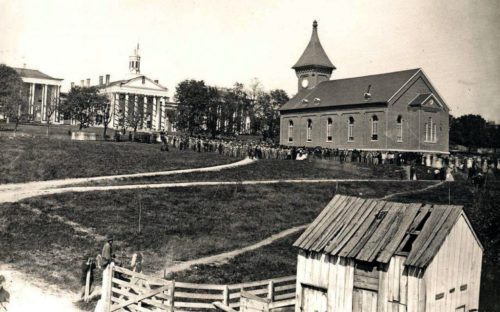
Challenging the prevalent myth surrounding General Lee, it is imperative to carefully scrutinize the idea that he enjoyed widespread popularity or favor. A detailed analysis of his funeral yields valuable insights into the genesis of this misconception. It becomes evident that characterizing him as a figure of broad acclaim requires reevaluation, as there are aspects of his legacy that paint him as a literal “monster”.
Start with this simple history fact:
On June 7, 1865, Underwood’s grand jury indicted Robert E. Lee for treason, charging him with “wickedly, maliciously, and traitorously” carrying on war against the Constitution and the “peace and dignity” of the United States of America. Lee faced death by hanging, if found guilty of the charges.
If Lee had been victorious in Civil War, it would have meant death to the Constitution (which he argued was failing its intended design to protect slavery). Thus he very correctly was charged with treason.
He embodied the epitome of tyranny, encapsulating the essence of the Old South within a singular individual. General Lee, a profoundly flawed aristocrat, is purported to have fought not merely for Virginia but explicitly for the preservation of his family’s wealth, predominantly derived from the particularly awful institution of American slavery (race-based kidnapping to breed human hostages for profit). This sentiment is articulated in a notorious and frequently referenced letter addressed to his sister in April 1861.
With all my devotion to the Union and feeling of loyalty and duty of an American citizen, I have not been able to make up my mind to raise my hand against my relatives, my children, my home.
However, it’s easy to see through his words as little more than “loyalty” hype. Copious documents show the man was neither loyal to his own family nor his state.
Lee in 1857 took ownership of nearly 200 people formerly held hostage (enslaved) by his father-in-law. Lee had been given the very specific instruction in that man’s will to set them all free within five years.
In other words, at the moment in 1861 he is supposed to show loyalty to family Lee instead falsely grouses he can’t raise a hand against his relatives while he is doing exactly that — refusing to honor his father-in-law’s very specific wishes.
Lee turns against his own by selfishly and tyrannically abusing at least 189 “family” members being held hostage in his “home”. Unilaterally he begins a cruel practice of systemically destroying families he had inherited. Why? His family practices were ruptured by him for no reason other than greed and hate, breaking up his owned families by treating people in his home like animals he very brutally detained to sell instead of set free as he had been ordered to do.
…Pryor writes that “Lee ruptured the Washington and Custis tradition of respecting slave families” by hiring them off to other plantations, and that “by 1860 he had broken up every family but one on the estate, some of whom had been together since Mount Vernon days.” The separation of slave families was one of the most unfathomably devastating aspects of slavery, and Pryor wrote that Lee’s slaves regarded him as “the worst man I ever see.” The trauma of rupturing families lasted lifetimes for the enslaved—it was, as my colleague Ta-Nehisi Coates described it, “a kind of murder.”
Some contend that General Lee’s actions (holding humans hostages and breeding them like animals for cruel profit) can be dismissed as mere attempts to bolster his financial standing like George Washington was known. However, such a perspective overlooks the core of his actions, which involved the dismantling of familial traditions and the rupture of close relationships in pursuit of his own ambitions for power and profit. The betrayal of loyalty is starkly evident in his willingness to raise arms against his own kin.
In a rather damning narrative, Lee is characterized as having “kind of murdered” his own familial bonds, blatantly opposing the very foundations of those connections. This domestic disloyalty raises questions about his character and sheds light on a darker aspect of his personal history.
Given this apparent betrayal within his own household, it is perhaps unsurprising that a man deemed the “worst” in his domestic sphere would subsequently undertake actions to undermine the very nation he had sworn to defend. The parallels between his disloyalty to family and his subsequent role in attempting to dismantle the Union become a subject of noteworthy consideration.
Furthermore, the discussion often centers around the falseness of Lee’s professed devotion to the Union. This aspect, frequently scrutinized, underscores the complexity of his loyalties and prompts a deeper examination into the motivations behind his decisions.
Lee’s family life and career were something like a boiling mess of cheating and domestic strife, which should have been seen as foreshadowing for his unfaithful violence against America.
…Mary Custis Lee, the wife, grandchild of Martha Washington, a badly spoiled and unpleasant woman, 30 years an invalid, who was often separated from her husband and preferred life with father in the Arlington mansion. The solace Lee sought from numerous other women apparently never came to consummation. On top of this was an unhappy military career, which took 30 years to earn Lee the rank of colonel. By the decade before the war, Lee had become subject to spells of deep depression, fits of morose behavior, occasional outbursts of violent temper and an obsession with death that amounted to “an almost suicidal tendency.”
Accordingly, Lee was reckless in his march into a war where he cared little about humanity and soon he was held to blame for causing a staggeringly cruel death toll of Americans, doing little or nothing despite being aware when his men committed gross atrocities.
During his life and for several years after his death in 1870, Lee was subject to severe criticism, North, South and abroad.
The severe nation-wide and even global criticism was well founded.
Lee had very intentionally denied care to wounded American soldiers. He betrayed his entire country, a republic, with an aim of terrorizing and slaughtering Americans to expand a violent tyranny of his family, such that only a few white elitist men (his male relatives, particularly his son) were supposed to rule over all women and non-whites.
That’s not exactly a popularity boost for anyone’s funeral even in 1870.
Don’t get me wrong, though.
Throughout history, there existed individuals who, embracing General Lee’s vision of substituting American governance with tyranny, aligned themselves with his cause to perpetuate and expand slavery as a purported entitlement for the white race. Presently, these adherents are recognized as the Ku Klux Klan (KKK).
These domestic terrorists favored his barbaric tactics, aiming to continue them in civilian conflicts even after defeat on the battle field. Some pushed it as a bogus “Christian Soldier” myth as a form of religious extremism (e.g. Crusade, Jihad) and some kind of lame excuse for Lee’s unmistakable cruelty and unnecessarily high casualties. When Grant maneuvered time after time towards decisive victories, capturing huge numbers of enemy soldiers, Lee instead mired his men into hopeless withering defeats and unnecessarily high death tolls as if a blueprint for mass shootings even 150 years later.
Grant’s brilliant coordinated offensives 1864-1865 not only significantly shortened the war through decisive combined-arms victories, he demonstrated true national leadership with broad vision and humanitarian aims. By comparison Lee never achieved more than a Colonel’s work despite three decades of service, clearly suffering from severe combat myopia.
In this context, the funeral of General Lee serves as compelling evidence of how his once formidable popularity waned, a consequence directly linked to his personal and professional deficiencies. Over time, this decline became so pronounced that he passed away in relative obscurity just a few years after subjecting his own family and followers to harsh treatment.
Bluntly stated, it was Lee’s descent into relative obscurity that likely spared him from facing a very public reckoning for his failures. Some conjecture that General Grant played a discreet yet pivotal role in ensuring Lee’s avoidance of a harsh fate. True to his character, Grant, with unwavering integrity and humility, refused to yield in a disagreement with President Johnson. Privately, Grant insisted that Johnson accept terms ensuring compassionate treatment of the defeated soldiers, a stance that further endeared the heroic General to the very men he compelled to surrender. This wasn’t solely about Lee; rather, Grant stood resolute in upholding what he deemed right for the collective welfare of all involved.
Had the Confederate General with a history of failures more prominently stuck his neck out and tried to remain a relevant political or even public figure after the Civil War it seems likely he would have ended up hanged.
In his [June 1865] instructions to the grand jury, Judge John C. Underwood described treason as “wholesale murder,” and declared that the instigators of the rebellion had “hands dripping with the blood of slaughtered innocents.” In early 1866, Lee decided against visiting friends while in Washington DC, for a congressional hearing, because he was conscious of being perceived as a “monster” by citizens of the nation’s capitol. […] Andrew Johnson didn’t overlook Lee’s pardon application because a required oath had gone missing. He deliberately chose not to pardon Lee because the southern commander was under indictment for treason. In late 1865 and early 1866, Andrew Johnson, famous at the time for his vow to make treason odious, fully intended to have Lee prosecuted and punished under Article III, section 3 of the US Constitution… death by hanging if convicted.
Read that again: “Lee was conscious of being perceived as a ‘monster’ by citizens…”
Indeed, barred from holding any public office or exercising the right to vote in elections, this individual characterized as a “monster”—who perpetrated the heinous acts of murdering his own family and fellow citizens—retreated into obscurity. From this concealed position, he persisted in perpetrating his form of terrorism against American families.
Lee took up a post as president of a small militant extremist training school, a regional “Washington College” in Lexington, Virginia (a school he fit into well, given it owned human beings and benefited from their forced labor and enslavement, not to mention reputation for raping black girls).
…students at Washington formed their own chapter of the Ku Klux Klan, and were known by the local Freedmen’s Bureau to attempt to abduct and rape black schoolgirls from the nearby black schools. …Lee was as indifferent to crimes of violence toward black people carried out by his students as he was when they were carried out by his soldiers.
Did you know Rosa Parks was the top investigator for the NAACP when she focused on this particular legacy of Lee?
More than a decade before Parks became a civil rights hero for refusing to give up her bus seat to a white man, Parks led a national campaign against sexual assaults on black women.
And did you know that memorials to Southern Confederacy even to this day are meant to promote domestic violence against American women?
Julian Carr spoke at the dedication of the monument in 1913 [center of McCorkle place on the UNC Campus, Chapel Hill, NC]. His speech recounted the heroic efforts of the men the monument honored… “100 yards from where we stand, less than 90 days perhaps after my return from Appomattox, I horse-whipped a negro wench, until her skirts hung in shreds…”
And that’s not even to get into the fact that while Lee allegedly ignored the well-known and systematic rape of Black women he also locked away his daughters refusing them any freedoms at all, such that they could serve only his wants and no other life or purpose.
[Lee’s daughter Mildred] had many suitors after the war but turned them all down, as none of them matched up to her father [who impatiently kept her isolated]. He relied on her to run the household after he accepted the position as head of Washington College and they moved to Lexington, Virginia. […] A friend of the family asked if she could write a book about Mildred’s life, but Mildred responded that she had not done anything worth the world to know. “[T]he true history of my life – and I suppose of any woman’s – would read stranger, sadder, more inexplicable than any romance that ever was written.”
One cannot help but contemplate whether General Lee, had he remained faithful to his familial and sworn duties to defend the Union, might have spared his children from the peculiar melancholy and “strange” sadness they endured. The incarcerated existence of his daughters appears most aptly characterized as a desolate and futile servitude to an unfaithful tyrant.
Then Lee abruptly died from heart disease on October 12th, 1870 (just five years after the end of Civil War).
Records tell us at this point very few mourned the “monster” outside of his militant school and some former circles of slaveholder politicians.
The numbers don’t lie.
The school even had to turn its “cadets” into his pallbearers and the small funeral procession was over almost as quickly as it started.
Order of Procession as “Escort of honor, consisting of officers and soldiers of the Confederate Army. Chaplain and other Clergy. Hearse and Pall-Bearers. General Lee’s Horse. The Attending Physicians. Trustees and Faculty of Washington College. Dignitaries of the State of Virginia. Visitors and Faculty of V. M. Institute. Other Representative Bodies and Distinguished Visitors. Alumni of Washington College. Citizens. Cadets V. M. Institute. Students Washington College as Guard of Honour.” It continues, in part “At 10 O’Clock, Precisely, The Procession (except as hereafter designated) will be formed on the College ground, in front of the President’s House and will move down Washington Street… The Procession will be halted in front of the Chapel… when the Cadets for the Institute and the Students of Washington College will be marched through the College Chapel, past the remains…
These details are captured in an auction piece.
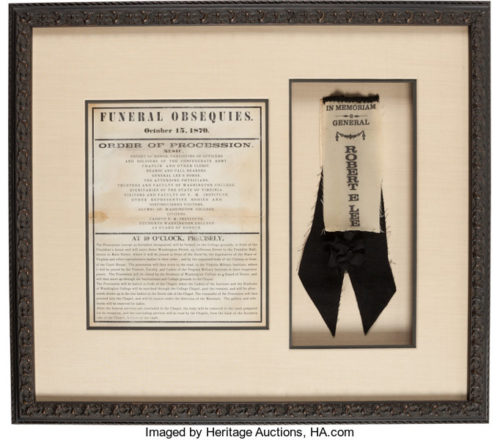
And it’s confirmed also in an 1883 recount of the funeral.
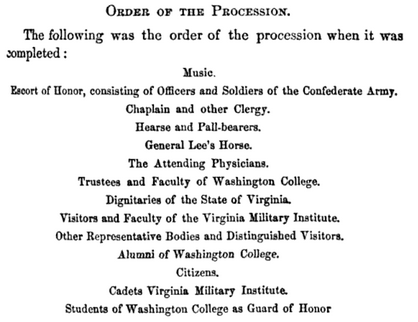
To put it another way a small regional school and some former seditious officers showed up dutifully, as well as slaveholder politicians, in total numbering barely over 1,000 people.
That’s essentially nothing, given he had only recently stopped being the head of a secessionist military with lofty aims of destroying America to replace it with a slave state.
He had more than 20X that number preparing to fight a last battle when he surrendered just a few years prior. Think about that. Four years after more than 20,000 men answered his call to invade and destroy America only a few showed up to pay Lee any respect at his funeral.
Thus, the defeated General Lee died with a negative score in his battles, losing a massive war badly with excessive loss of life. He had not regained his citizenship, nor was he personally/formally pardoned officially for treason let alone leading a fight to destroy the American Constitution.
Nonetheless his body was allowed to receive a “military salute” from the tight circle of his own cadets at his school.
Tributes were mentioned from just eight cities:
- Louisville, Kentucky
- Augusta, Georgia
- New Orleans, Louisiana
- Atlanta, Georgia
- Richmond, Virginia
- Columbia, South Carolina
- Baltimore, Maryland
- Lexington, Kentucky
Eight cities.
In a nutshell, Lee stopped his fight to expand slavery (ending the entire basis of his public career) while wearing suspiciously shiny boots and unused sword to a ceremonial surrender to General Grant at the Appomattox Court-House on April 12.
I felt like anything rather than rejoicing at the downfall of a foe who had fought so long and valiantly, and had suffered so much for a cause, though that cause was, I believe, one of the worst for which a people ever fought, and one for which there was the least excuse. […] General Lee was dressed in a full uniform which was entirely new, and was wearing a sword of considerable value, very likely the sword which had been presented by the State of Virginia; at all events, it was an entirely different sword from the one that would ordinarily be worn in the field. […] General Lee, after all was completed and before taking his leave, remarked that his army was in a very bad condition for want of food, and that they were without forage; that his men had been living for some days on parched corn exclusively, and that he would have to ask me for rations and forage. I told him “certainly,” and asked for how many men he wanted rations. His answer was “about twenty-five thousand”…
The fancy well-heeled shiny-sword elitist Lee, grinding his 25,000 suffering and starving men into early graves, passed quickly from public thoughts (despite occasional rants intended to deny Black Americans any voice in politics) and very few cared to inquire about his fate, foreshadowing why his own cadets in a small college in an obscure town were tasked with being his pallbearers.
It’s interesting to also note that President Andrew Johnson could not call Civil War officially over until all Confederate leaders met Union General Grant’s demands. When Lee surrendered he said he stood only for the Army of Northern Virginia, and that he did not lead but a few men.
The famous Grant-Lee agreement thus became a signal from the Union that any ongoing fight to preserve slavery was over; a model of surrender for large armies of the Confederacy who didn’t see Lee as leader yet still aligned with his unjust cause. It would be another 16 months after Appomattox until Grant dominated all and (on August 20, 1866) the U.S. President formally declared threats to the Constitution were ended.
In one peculiar case demonstrating shameless cowardice, on April 21 just days after Lee’s surrender, Confederate Colonel John Singleton Mosby told his own men they were abandoned:
I disband your organization in preference to surrendering it to our enemies. I am no longer your commander.
Mosby’s men walked away from this “ghost” of a leader into various groups wandering in various directions; they surrendered despite Mosby’s melt-down under pressure. Being “on your own” surely had little value to his troops as they already head been on their own — surrender brought them care from Union leadership who served their needs, including basics like being fed and clothed.
It was in this context of abandonment and purposefully weak leadership that Lee’s body was buried under a small school church, when its name was abruptly changed from just the slave-catcher Washington by adding… Lee.
Eight regimental Confederate Battle flags were set to surround a tiny recumbent statue carved of Lee in this suddenly renamed “Lee Chapel”. Private donations had to be solicited to pay for statue chamber and family crypt for Lee that was built onto the Washington Chapel.
A sudden rise of interest in promoting Lee’s name after he couldn’t be hanged for it? To what end? This was exactly what Lee said he didn’t want: anti-American flags were flown in an American school chapel (until 2014), even becoming an events center of anti-American militant groups (until 2016).
Hold that important century-long fund-raising point for a minute.
Here’s how the Army and Navy Journal on August 28, 1869 quoted Lee in regard to a Gettysburg gathering to remember the dead.
In the face of the published assurances that General Lee would like to be present, a [August 5th] letter is published from him, in which he says: “My engagements will not permit me to be present. I believe, if there, I could not add anything material to the information existing on the subject. I think it wiser, moreover, not to keep open the sores of war, but to follow the examples of those nations who endeavored to obliterate the marks of civil strife, to commit to oblivion the feelings it engendered.
General Fitzhugh Lee (nephew of General Lee) is similarly quoted in the Army and Navy Journal:
I rather think, though, and I write it in all kindness, sir, that if the nation is to continue as a whole, it is better to forget and forgive rather than perpetuate in granite proofs of its civil wars.
Lee and Lee’s family both asked to “obliterate the marks’ and prevent “granite proofs” such as statues… yet the exact opposite happened.
By the 1900s it became fashionable to solicit large private donations to create marks of civil strife in America and litter the countryside with “granite proofs” of the man and family who said please don’t; higher numbers of murder (lynching victims) correlate directly to location of a Confederate “symbol” (e.g. Lee).
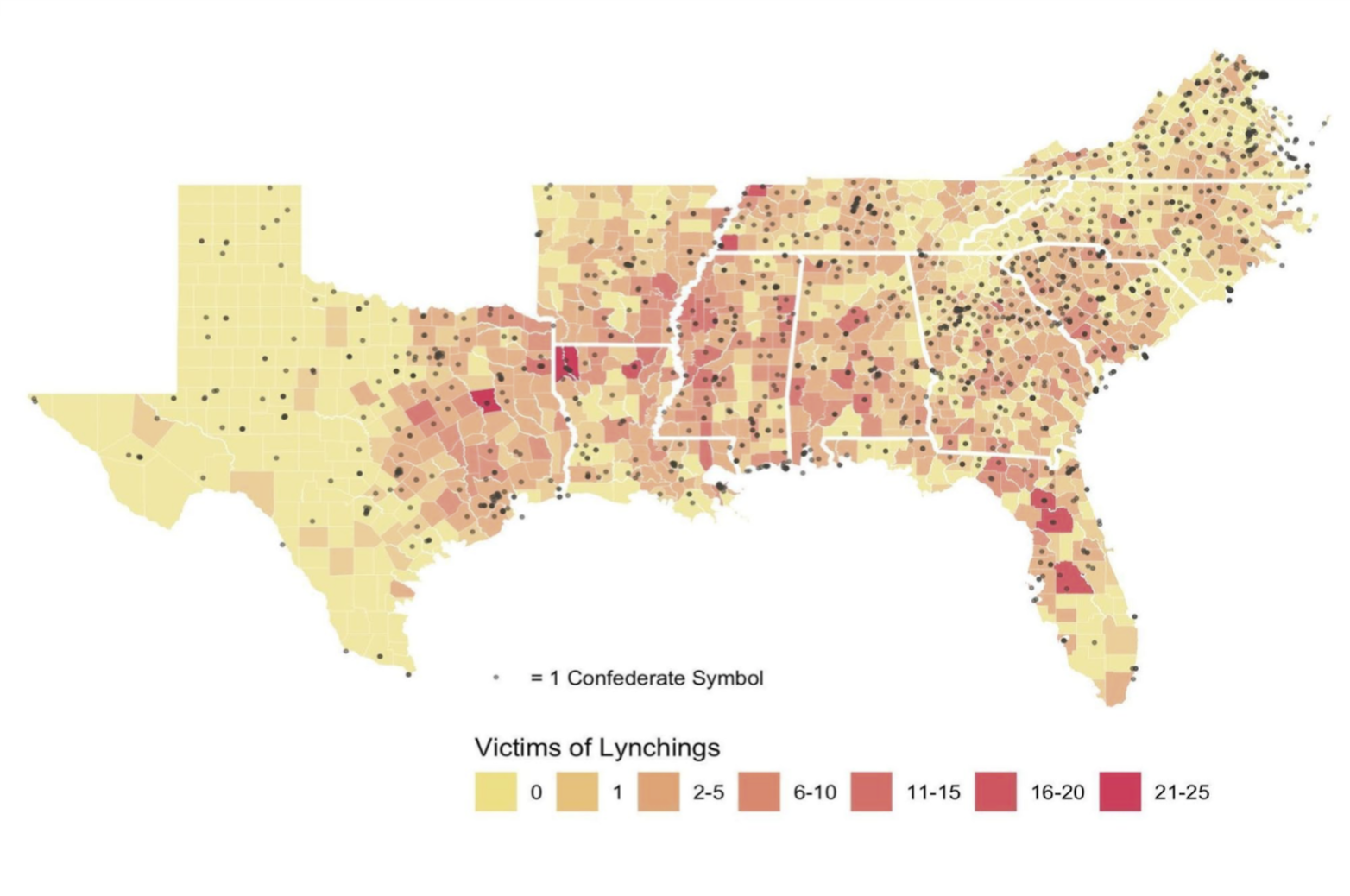
Lee’s burial, as small and obscure as it was, was still a contradiction to Lee’s supposed wishes to bury signs of his rebellion. It became an encoded shrine to organizing violence and perpetuating the Civil War “like a contagion” that Lee supposedly quit.

Lee’s overt failures at basic humanity have become an asset for others after his death, given how funds find their way into schools that continue to turn a blind eye to domestic terrorism (add a Lee memorial to campus). Apparently it includes VERY large funds. How many Americans know, for example, one of the nation’s richest men JP Morgan Jr refused to pay taxes while also securing nearly $100m in loans to Mussolini to expand fascism?
The Washington and Lee school have thus doubled-down on using Lee to stoke donations for hate, as they repeatedly refuse to return their name to its original version (directly disobeying Lee’s own request to “obliterate the marks of civil strife”).
The school has even literally cited removal of the late name addition as “a threat to current financial support”, openly admitting use of Lee’s name after he no longer was alive to be hanged has always been about stoking cash donations through manipulating sentiment for money from wealthy domestic terror financiers.
The commission, which studied the history of the university, noted that the sculpture and other imagery in the chapel were part of an effort in the South in the late 19th century and beyond to make the Confederacy a great cause, worthy of veneration, and to make Confederate heroes into something akin to saints. “By continuing to hold rituals and events in Lee Chapel, the university, wittingly or not, sustains the Shrine of the South and the memory of Lee as a commander of the Confederate Army,” the report said. “The commission heard repeatedly in its outreach that the effect is problematic for many students, faculty, staff and alumni.” Notably, the commission said, orientation of new students takes place in the chapel, as does the signing of the honor code.
This brings to mind a similar argument made in the early 1980s when this school’s leadership literally said it would rather shut everything down than allow any women to be educated, as if less misogyny somehow posed a dire threat to its financial stability.
It finally relented in 1985, despite white male alumni vociferously arguing that their “values” (surely more than just their legacy of raping Black women) would be “compromised” by women.
Many of the current students at the time and alumni attended Washington and Lee for its strong conservative values, and felt like those values would be compromised if the university began to admit women.
Of course the opposite happened and the school’s finances are fine while it now ranks in the top 5% of male/female diversity (50/50). However the racism still exists and Lee’s name translates directly to shockingly low numbers of Black Americans on campus. Only 40 faculty out of 1,000 and just 90 students out of 1,800 are Black.
The monumental attachment to a misogynist racist “monster” like Lee is unquestionably meant as an intentional way to solicit money and make Black Americans feel so unwelcome as to deny them education.
General Lee’s funeral and its relics, as obscure and small as it all was initially, has grown into an encoded way for people to keep the Civil War unresolved — try and squeeze money out of what has become known as the “Lost Cause” fraud.
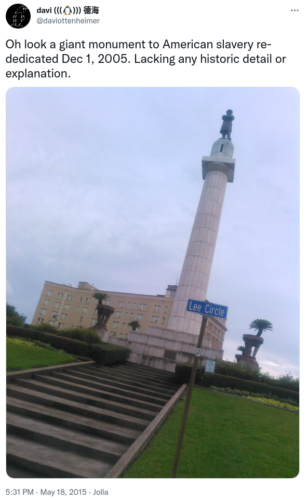
Presently, General Robert E. Lee’s historical stature appears diminished, assuming a role akin to a symbolic figure devoid of substantive meaning. His name is invoked predominantly to solicit support from white supremacist factions and to exacerbate racial tensions. This occurs concurrently with a discernible lack of reverence for Lee, as his elevation to public scrutiny reveals deficiencies in meeting even the most rudimentary criteria (where he fails even the most basic tests).
Obviously the US isn’t going to name a federal building in Oklahoma after Timothy McVeigh, nor is it going to name a sky scraper in NYC after Osama bin Laden. My how times have changed [since a monster like Lee had his name spread around like peanut butter]!
For important comparison, in 1885 when Grant died he was so revered by everyone that his pallbearers included even the Confederate Generals who had surrendered to him. He was globally mourned as a hero in what was recorded as the largest funeral in history; millions attending in a procession seven miles long that took almost all day and filled NYC. And — very unlike the fraudulent Lee monument and flag gravy train — if you would like to purchase something in Grant’s honor to commemorate actual great deeds of a US General and President, it’s called an American flag.
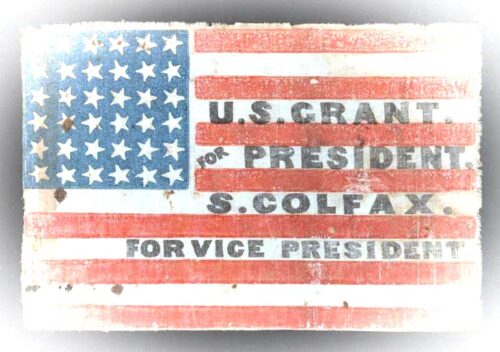
This author is totally insightful and has clearly represented the very sad character and postwar actions of Robert E. Lee. This article is a total representation of the truth and is a noble attempt to correct history. 1865-70 was a different time and circumstance than 2021.
This article is great and worth the time to read fully!
Lee was obviously consumed with hatred for Black Americans. Enough said……
I am so glad to find this blog instead of yet another half-truth, amateurish, PC based, hatchet job hack “article” promoting the fraud of Lee. He quit being American, dumping decades of WEAK pre-war service only to HIMSELF, revealing a tragically flawed character. Any true article on him will call him a WAR CRIMINAL. It’s long past time to get busy destroying his revisionist statues. Too many TRULY LAUGHABLE lies online, the REAL FRAUD Sir is LEE!
This article is truth!! The author really knows the disgrace of General Robert E. Lee.
What a remarkable article! If only history classes could teach the truth about Lee and the Confederacy.
Once again, southern media sources fail to tell a true story about the names of Confederate officers. Thank you. In your quest to preserve real history, you put things in contest and I appreciate hearing your own ideas and opinions. You help our youth to tear down bogus/revision statues like Lee, restore historical places, and get rid of symbols of hate. I do not care about skin color nor politics. The Civil War should never have happened. If only the South had not invaded the North, and negotiated with educated men, slavery should have died in the 1820s. The war was about states trying to claim a right to preserve slavery and expand it west. Human life was so cheap to Southerners about half the white population in places like Mississippi claimed they didn’t have money enough yet to own a black girl (to rape her and produce babies to sell at a market like animals) so they hoped the war would make slavery even less costly to them. Talk about dividing our nation, history facts like yours are great to expose people with disgusting pro-slavery thinking.
Excellent retelling of what happened 100 years ago. Finally understand what it was like to whiteness it personally. Unlike so much hearsay, this is a truthful telling of how Lee remained in death the enemy of America. History is written by the historians. Lee was a loser in every way even to this day.
Your blog is a national treasure. We need more history writing like this.
One of the most insightful history pieces that could be published. This should be required reading in American schools, especially W+L and others implicated in the systemic abuse of black women.
What an absolutely historically literate and grounded take that is utterly refreshingly full of truths and out and out insights. Better yet, is all the colleagues in the comment section moving towards each other in shared realization.
This is of historical significance, one of the hallmarks of the learned scholar.
It is great to see a unbiased telling of Lee’s failings. The critical reads as an unbiased piece rather than opinion and telling of the man’s misguided loyalty.
Complete history written by an expert with true understanding of the events and the man.
Wow, this article on historical analysis is actually pretty amazing! It does a fantastic job of giving us a well-rounded view without pushing any personal agenda. The writing is so engaging and genuine, not filled with any of that biased stuff or hidden motives.
And check out the other responses – they’re all so authentic and supportive. It’s clear that a bunch of different people genuinely appreciate the depth of this historical analysis. Their feedback adds such a real and positive vibe to the article.
It’s refreshing to come across a post that takes a more balanced and critical approach when discussing General Lee. Discussions about him from the propaganda mill of the “South” have been so obviously artificially and overwhelmingly positive, your honest take adds a layer of depth and authenticity to the conversation. It’s essential to explore different perspectives to gain a more comprehensive understanding, and your contribution does just that. Thanks for bringing a thoughtful and nuanced view to the table!
It seems like you have a genuine passion for Southern history and a deep appreciation for the love Southerners have for racist monsters who make it ok to be racist monsters. Your commitment to historical accuracy and understanding the cultural context is commendable. The real reason Lee’s funeral was small was mainly due to poor whether. The roads were muddy. People couldn’t find their rubber boots. And it was cold. Nobody had a warm jacket to wear. They couldn’t go because the hill was hard to climb. Who wants to walk up a hill? You think Southerners want to suffer? Why do you think they had slaves? Lee truly was loved by at least one or two Southerners (although not his own imprisoned daughters). To suggest nobody came to his funeral because they couldn’t be bothered, is quite literally a truth about the back-stabbing South nobody wanted you to talk about.
Consider the stark reality that Robert E. Lee defied a century of abolitionist progress by fathering children with enslaved women. One prominent example is Mary Anna Custis Lee, a woman held in bondage by his wife whom he sexually assaulted. It’s possible that Lee’s apparent inclination toward the systemic exploitation of women, alongside strained relations with his military superiors, may have been influential factors leading to his decision to betray his country and wage war against the United States.
Reflect on this: Lee may have envisioned a future where he could continue to exploit women unchecked, leveraging his undeserved ascent to a prominent military position within a terrorist faction. His aim might have been to evade accountability both personally and professionally. However, his performance on the battlefield proved disastrous, marked by the highest casualties and repeated strategic blunders. Moreover, his conduct at home was equally reprehensible.
To suggest that Lee failed basic moral tests in his roles as a husband, father, or in ascending beyond the rank of colonel would be a gross understatement.
“Monster” is indeed an apt term to describe this evil man.
this article is so good
Thank you for sharing your perspective on Robert E. Lee. As a fellow Civil War researcher, I wanted to engage thoughtfully with your analysis. Recent scholarship, particularly feminist historical works, has revealed important new insights about Lee that warrant serious discussion. The evidence from Lee’s personal correspondence and contemporary accounts, combined with recent academic analysis of his treatment of enslaved women, presents a troubling pattern that earlier historians often overlooked or minimized.
Your article raises crucial points about Lee’s direct involvement in and profit from the institution of slavery – something he himself acknowledged in his letters. Modern historians have built on this foundation to document how his actions impacted women specifically, both free and enslaved. The work of several feminist scholars has been particularly illuminating in examining primary sources through an intersectional lens of gender and race.
While earlier biographical works often painted a more sympathetic portrait, recent rigorous academic research has helped us better understand Lee’s complex legacy, particularly regarding gender dynamics and power relationships. You make a compelling case for reassessing historical figures through contemporary ethical frameworks rather than the standards of their time.
I appreciated how you grounded your argument in both primary sources and contemporary scholarship. Perhaps we could further explore some of the newer feminist historical analyses that have emerged in recent years? I believe incorporating these perspectives enriches our understanding of this complex historical period.
Thank you for contributing to this important ongoing discussion about how we reckon with historical figures and their legacies.
One additional point on your initial comment that Lee’s funeral was mistakably small.
Let’s think about this – in the 1870s, when people regularly crossed hundreds of miles on horseback, traversed wilderness to establish homesteads, and built entire railroads through mountains… a little rain kept devoted followers away from Lee’s funeral. That says a lot.
And his casket situation is even more telling. We’re talking about a society that could build warships, construct extensive railway networks, and rebuild entire cities – but apparently couldn’t manage to craft a simple wooden box in Lexington, Virginia? A town full of carpenters and woodworkers, surrounded by forests, somehow couldn’t produce a suitable casket for what would have been considered a monumentally important occasion – if people had actually considered it so?
Low attendance rather proves the point. When Lincoln’s funeral train traveled through the North, millions turned out despite snow, rain, and mud. When Frederick Douglass spoke, people walked for days to hear him. When Jefferson Davis traveled through the South after his release, crowds gathered despite any obstacles.
So yes, let’s do talk about that suspiciously empty funeral. Sometimes the simplest explanation – that Lee’s popularity was far more limited than Lost Cause mythology would later claim – is actually the correct one. No amount of rain (salty tears of the Confederate families trying to profit on Lee’s name) can wash away that historical reality.
Lee’s monstrous atrocities against humanity will haunt him forever A southern disaster, a traitor to America. Appreciate ur history here.
Nobody would even remember dude at all without so much trash fantasy fiction that’s been trying to puff up white nationalism in his name because they ain’t got nobody better than a guy who shined his boots just to stare at his own reflection while his men died
I don’t understand how Grant and Lincoln aren’t scrutinized as much, if not more, than Lee? Lincoln only issued the emancipation proclamation because he needed more troops to send to slaughter so he could win reelection and Grant single handedly sent tens of thousands of men on suicide missions. The civil war was so horrific, hideous, senseless… how is it that the deaths/slaughter of nearly a million white men are just so quickly forgotten when Lincoln didn’t even end slavery. The south continued doing whatever it wanted long after the civil war and Lincoln didn’t even follow through with a plan after he got what he wanted, which were thousands of slaves to join the union and die within the first 10 minutes in battle.
@Brin Kessey
Wow! It’s like you ate a can of Confederate Alphabet Soup and came here to take a dump. The evidence is clear for anyone willing to look beyond such propaganda. Lee very clearly preferred treason, in his defense of slavery. Attempts to whitewash his “monsterous” brutality, as documented above, began immediately after his death and obviously continue in minds like yours.
To be clear, you are spreading blatant historical falsehoods known as the Lost Cause propaganda platform. So, in order to preserve and protect America from another minute of the awful lies, let’s dance:
Lincoln vocally opposed slavery’s expansion for many years before the war. The Emancipation Proclamation fundamentally changed the war’s purpose and aligned military necessity with moral imperative. That’s not troop numbers. Lincoln pushed for the 13th Amendment to permanently abolish slavery nationwide, which is a most literal opposite to your baseless comment he was “not ending slavery.”
General Grant’s campaigns showed a strategic brilliance that the “Colonel” Lee never could match. Grant understood that defeating the Confederacy was about sustained pressure on Lee’s many vulnerabilities. Unlike Lee, who suffered the absolute highest number of casualties in his reckless offensives like Gettysburg, Grant delivered the exact opposite. Grant captured multiple entire armies intact, preserved their lives, and is credited even to this day for pioneering modern warfare tactics. Calling Grant’s generalship “suicide missions” is the most absurd revisionism, especially when you consider Lee refused aid to the wounded, murdered his prisoners of war, and resorted to suicidal trench warfare tactics.
While Lee was carelessly getting his men killed in hopeless charges, Grant captured entire Confederate armies at Fort Donelson and Vicksburg amazingly minimizing harm to his own men.
Captured entire armies! Get it?
Grant’s Overland Campaign succeeded through persistence and strategy. We’re comparing one of the best military minds in history with Lee’s troops struggling to survive on parched corn because the uncaring “monster” they followed was hiding in his tent polishing his fancy boots and sword, too “busy” to surrender and save his men from starvation.
The fact that Lee’s funeral was so poorly attended—as thoroughly documented in this article—speaks volumes about his actual popularity.
If he was such a beloved hero, why did so few people show up to mourn him? It’s no wonder his former neglected soldiers couldn’t be bothered to attend. Your claim about “nearly a million white men” killed is pure fabrication. The total death toll from the Civil War was approximately 620,000-750,000 soldiers from both sides combined. Inflated numbers doesn’t strengthen anything; it just reveals your distorted focus on “forgotten” sacrifice while totally ignoring millions of Blacks tortured and killed in slavery.
Lee wasn’t just any officer—he was a West Point graduate who swore an oath to defend the Constitution, then betrayed that oath to fight for a government created explicitly to preserve human bondage. That’s the textbook definition of treason, which is why he was indicted for it. The fact he wasn’t hanged for his treason was Grant intervened and saved his life. Do you even have a clue about Grant’s reputation, the man who was wisely regarded as a global hero, given how the whole world mourned his passing?
Meanwhile Lee died an obscure nobody, President of a small college of white boys known locally for creeping around at night to rape black girls.
The Civil War was not “senseless” given how it was explicitly started to preserve and expand slavery, as Confederate leaders had openly declared intention to replace the Constitution with their own vision. Their plan was to push slavery West and then rotate back to completely destroy the North, replacing democracy with a tyranny of white men. The South “continued doing whatever it wanted” because of the violent overthrow of Reconstruction (continuation of Civil War) by white supremacist terrorist groups and the federal government’s abandonment of freed people.
Your comment exemplifies perfectly how Lost Cause mythology warps the mind of some into unhistorical babble. It shifts blame away from the overtly hateful, violent Confederate leaders who instigated treasonous war to profit on human bondage and trafficking. You think we should find fault instead with the brilliant white men like Lincoln and Grant who defeated slavery to establish freedom for all Americans? I wonder why? Hmmm.
The real question is whether we’re willing to face our history honestly, or if we need to create comforting myths about the worst “monsters” like Lee to avoid admitting that the Confederacy was built entirely on the singular and immoral foundation of raping black women for profit.